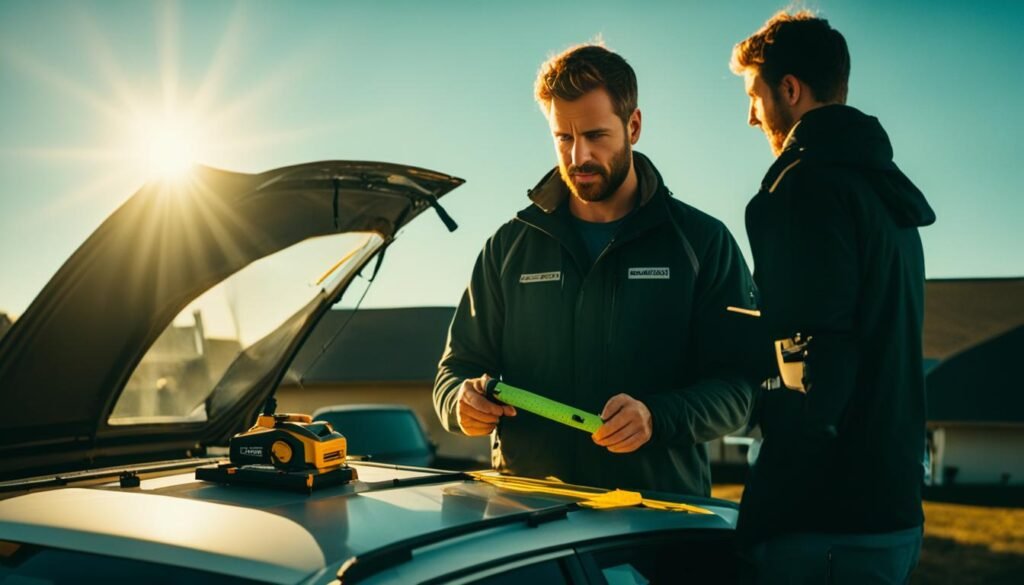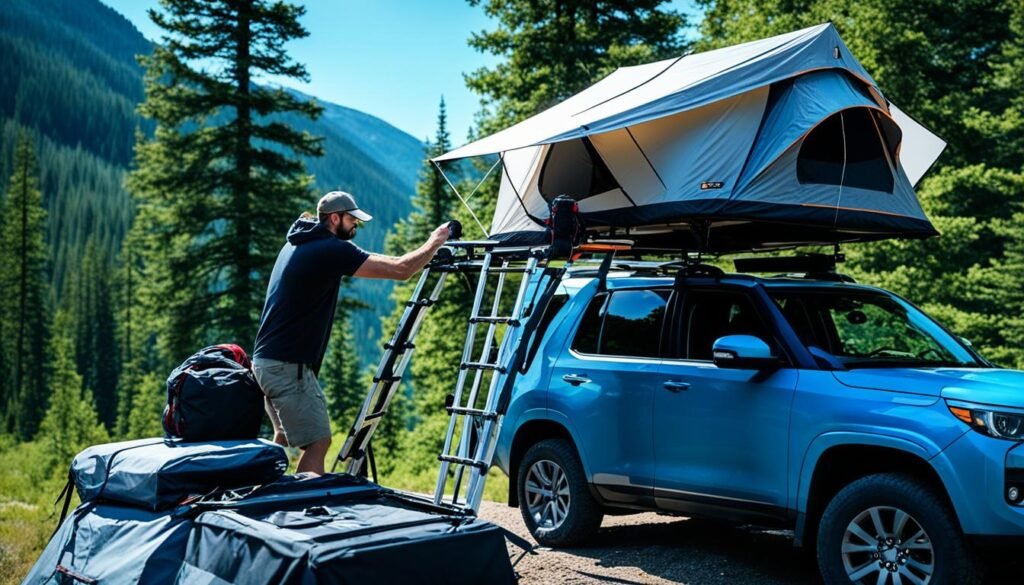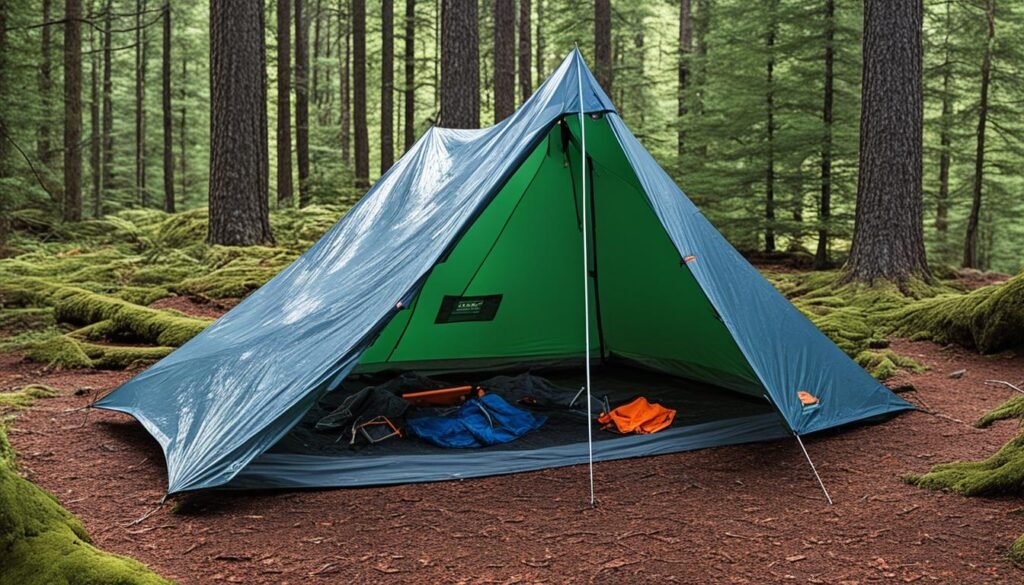Installing a rooftop tent by yourself can be a challenging task, but with the right techniques and tools, it is possible to do it solo. In this article, I will provide a step-by-step guide on how to put on a roof top tent by yourself, ensuring a safe and secure DIY installation on your vehicle.
Key Takeaways:
- Installing a roof top tent by yourself requires careful planning and the right tools and equipment.
- Before beginning the installation process, gather all the necessary tools, including an engine crane or lifting device, straps or lifting slings, a drill, and a toolbox with basic hand tools.
- Prepare your vehicle by ensuring that your roof rack is properly installed, clean, and free from any debris or obstructions. Adjust the height or position of your roof rack if needed.
- Lift and position the roof top tent using an engine crane or a similar lifting device, following the manufacturer’s instructions for securely attaching the tent to your vehicle.
- Secure the tent to your vehicle using the mounting brackets or plates provided, double-checking all connections and straps for a firm attachment.
Tools and Equipment Needed
Before you begin the installation process, it’s essential to gather all the necessary tools and equipment. You will need an engine crane or a similar lifting device to assist with the heavy lifting, along with straps or lifting slings to secure the roof top tent. Additionally, having a drill, drill bits, and a toolbox with basic hand tools will be helpful for attaching the tent to your vehicle securely.
Here are the tools and equipment needed for a successful roof top tent installation:
- Engine crane or similar lifting device: This will make the process of lifting and positioning the roof top tent much easier and safer.
- Straps or lifting slings: These will help secure the tent to your vehicle, ensuring it stays in place during travel.
- Drill and drill bits: You’ll need these to create holes for mounting brackets or plates.
- Toolbox with basic hand tools: Having a variety of wrenches, screwdrivers, and other essential tools will come in handy during the installation process.
By having these tools and equipment ready beforehand, you’ll be prepared to tackle the installation process with confidence and efficiency.
Preparing Your Vehicle
Before you can start installing the roof top tent, it’s important to prepare your vehicle. This will ensure a smooth and secure installation process. Here are the step-by-step instructions for preparing your vehicle:
- Check your roof rack: Make sure your roof rack is properly installed and in good condition. Inspect it for any signs of damage or wear.
- Clean the roof rack: Remove any dirt, debris, or obstructions from your roof rack. A clean surface will allow for better contact between the tent and the rack.
- Adjust the height and position: Depending on the size and weight of your roof top tent, you may need to adjust the height or position of your roof rack. Refer to the manufacturer’s instructions for the recommended placement.
- Check the weight limit: It’s crucial to ensure that your roof rack can safely support the additional load of the roof top tent. Check the weight limit specified by the manufacturer and make any necessary adjustments.
By following these self-guided roof top tent setup instructions, you will ensure that your vehicle is properly prepared for the installation process.
Lifting and Positioning the Tent
With your vehicle prepared, it’s time to lift and position the roof top tent. This step is crucial to ensure a successful installation that guarantees safety and stability during your camping adventures. To assist with the lifting process, an engine crane or a similar lifting device is recommended. Follow these steps to lift and position your roof top tent:
- Step 1: Carefully attach the lifting device to the tent, ensuring it is securely fastened. Pay attention to the weight limits specified by the tent’s manufacturer.
- Step 2: Using the lifting device, raise the tent off the ground while maintaining control of the lift. Take your time and ensure a steady and controlled movement.
- Step 3: Position the tent over your vehicle’s roof rack, aligning it with the mounting points. This step may require assistance from another person to ensure precise placement.
- Step 4: Gently lower the tent onto the roof rack, guiding it into position. Be cautious not to damage the vehicle or the tent during this process.
Once the tent is in position, it’s crucial to follow the manufacturer’s instructions for safely attaching the tent to your vehicle. This may involve using mounting brackets or plates provided with the tent, which should be securely fastened to the roof rack. Additionally, it’s important to secure the tent using straps or lifting slings to prevent any shifting during transport. Properly securing the tent ensures a stable and safe installation, allowing you to enjoy your camping experience without any worries.
“Properly lifting and positioning the roof top tent is crucial for a successful installation. Take your time and follow the manufacturer’s instructions carefully to ensure a secure attachment to your vehicle and a safe camping experience.” – Expert Camper
Securing the Tent
After lifting and positioning the tent, the next step is to secure it to your vehicle. This is an important part of the DIY roof top tent installation process, as it ensures that the tent is properly attached and will not come loose during travel.
Begin by using the mounting brackets or plates provided with the tent. These brackets are specifically designed to fit the roof rack of your vehicle, providing a secure attachment point for the tent.
Attach the brackets or plates to the roof rack, using the appropriate hardware and following the manufacturer’s instructions. It’s crucial to ensure that the brackets or plates are securely fastened, as this will prevent any movement or shifting of the tent while driving.
Double-check all the connections and straps to verify that the roof top tent is firmly attached to your vehicle. This includes inspecting the bolts, screws, or straps used to secure the brackets or plates to the roof rack, as well as any additional straps or fasteners used to secure the tent itself.
Take the time to carefully examine all the connections to ensure they are tight and secure. Any loose or weak connections can compromise the stability and safety of the installation.
Once you have completed the securing process, it’s advisable to give the tent a gentle tug or shake to test its stability. This will help identify any potential issues with the attachment and give you the opportunity to make any necessary adjustments before hitting the road.
Remember, proper tent attachment is crucial for a safe and enjoyable camping experience. By following these steps and ensuring a secure attachment, you can have peace of mind knowing that your roof top tent is ready for your next adventure.
Testing and Adjusting
Once the roof top tent is securely attached to your vehicle, it’s essential to test and adjust its position to ensure a safe and comfortable camping experience. Here are some steps to follow:
1. Check the Functionality of Zippers, Latches, and Closures
Inspect all zippers, latches, and closures to ensure they are functioning properly. Test them by opening and closing the tent multiple times to verify smooth operation and secure fastening.
2. Look for Signs of Instability or Shifting
Take a close look at the tent setup to check for any signs of instability or shifting. Look for sagging sections, loose straps, or other indicators that the tent may not be securely in place. Correct any issues before proceeding.
3. Make Adjustments for Stability
If necessary, make adjustments to the straps or mounting brackets to improve stability. Tighten the straps or screws as needed, ensuring a firm and secure attachment to your vehicle’s roof rack. This will prevent any movement or swaying while on the road.
4. Verify a Level Installation
Confirm that the roof top tent is level by using a spirit level or a built-in leveling feature, if applicable. A level installation ensures maximum comfort and stability while camping, preventing any discomfort or uneasiness while sleeping or relaxing.
Testing and adjusting your roof top tent’s position is crucial to ensure a safe and enjoyable camping experience. Take the time to make any necessary adjustments to guarantee a secure and level installation.
Safety Considerations
When undertaking the step-by-step roof top tent self-installation process, prioritizing safety is of utmost importance. Follow these guidelines to ensure a smooth and secure roof top tent solo installation:
1. Wear Protective Gear: It’s essential to protect yourself from potential hazards during the installation. Wear sturdy gloves to safeguard your hands from cuts and abrasions, and use safety glasses to shield your eyes from debris or flying objects.
2. Exercise Caution When Lifting and Positioning: Take your time and proceed with caution when lifting and positioning the roof top tent onto your vehicle’s roof rack. Mishandling heavy equipment can lead to injuries or vehicle damage. Utilize proper lifting techniques and seek assistance if needed.
3. Adhere to Manufacturer’s Instructions: Always refer to the manufacturer’s instructions specific to your roof top tent model and follow them meticulously. Each tent may have unique installation requirements, and deviating from the instructions may compromise safety.
4. Follow Best Practices: Familiarize yourself with the best practices for safe installation of roof top tents. Properly secure the tent using straps or lifting slings to prevent shifting during transport. Regularly inspect and tighten connections to maintain a secure installation.
5. Ensure Stable and Level Installation: A stable and level roof top tent is crucial for both safety and comfort. Periodically check the stability and levelness of the installation and make necessary adjustments to the straps or mounting brackets to ensure a secure fit.
“Safety should always be a priority when installing a roof top tent by yourself. It’s crucial to take the necessary precautions and follow proper procedures to mitigate any risks and ensure a successful, accident-free installation.”
| Safety Considerations | Description |
|---|---|
| Wear Protective Gear | Utilize gloves and safety glasses to prevent injuries during the installation process. |
| Exercise Caution When Lifting and Positioning | Take your time and proceed carefully when lifting and positioning the roof top tent to avoid injuries or vehicle damage. |
| Adhere to Manufacturer’s Instructions | Ensure you follow the manufacturer’s instructions for your specific roof top tent model to ensure safe and proper installation. |
| Follow Best Practices | Learn and adhere to the best practices for safe roof top tent installation, including proper securing and inspection. |
| Ensure Stable and Level Installation | Regularly check and adjust the stability and levelness of the installation to ensure a secure fit. |
Maintenance and Care
Once your roof top tent is installed, it’s essential to maintain and care for it properly. Regularly inspecting and cleaning the tent will help ensure its longevity and performance. Here are some key maintenance tips to follow:
- Inspect for wear and damage: Regularly check the roof top tent for any signs of wear, such as rips, tears, or loose fittings. Pay close attention to the seams and zippers, as they are prone to damage over time.
- Clean the tent: Remove any dirt, debris, or potential contaminants from the tent. Use a mild soap and water solution to gently clean the fabric, avoiding harsh chemicals that could cause damage.
- Dry thoroughly: After cleaning, make sure the tent is completely dry before folding and storing it. Moisture can lead to mold or mildew growth, which can deteriorate the fabric.
- Store properly: Follow the manufacturer’s recommendations for storing the roof top tent. Proper storage will help prevent unnecessary wear and damage while ensuring it’s ready for your next adventure.
Remember, regular maintenance and care will not only prolong the lifespan of your roof top tent but also contribute to a safe and enjoyable camping experience. Keep these tips in mind to make the most out of your DIY roof top tent installation and solo roof top tent setup.

Maintenance Checklist
| Task | Frequency |
|---|---|
| Inspect for wear and damage | Every month |
| Clean the tent | After each use or as needed |
| Dry thoroughly | Before storing |
| Store properly | When not in use |
Troubleshooting and Common Issues
While installing a roof top tent solo can be a straightforward process, there are occasionally some common issues that may arise. These can include difficulty lifting and positioning the tent, challenges with securing the tent to the vehicle, or problems with the stability or levelness of the installation.
If you encounter any of these issues, here are some steps you can take to troubleshoot and find solutions:
- Refer to the manufacturer’s instructions: The first step in troubleshooting any installation issue is to consult the manufacturer’s instructions. They will often provide guidance on common issues and how to address them.
- Seek assistance from other experienced users: Online forums and communities dedicated to roof top tents can be valuable resources for troubleshooting. Other experienced users may have encountered similar issues and can offer helpful advice or solutions.
- Inspect the setup: Go through each step of the installation process and carefully inspect the setup. Check for any loose connections, missing parts, or improper installations. Adjust and tighten as necessary.
- Double-check the stability: Ensure that the roof top tent is securely attached and stable on your vehicle. Check the straps, brackets, and mounting points to make sure they are properly fastened and tightened.
- Ensure levelness: If you notice any tilting or unevenness in the installation, use a level to check the alignment. Adjust the position or mounting points to achieve a level and stable setup.
Remember, troubleshooting may require some patience and trial and error. Take the time to carefully assess the situation and make necessary adjustments.
With these troubleshooting tips and solutions, you can overcome common issues that may arise during the installation of a roof top tent. By addressing these challenges, you can achieve a safe, secure, and enjoyable camping experience.
Alternative Methods and Tools
While an engine crane is an effective tool for lifting and installing a roof top tent solo, there are alternative methods and tools that can be used. Some individuals use ladders, pulley systems, or winches to assist with the installation process. These methods may require additional equipment and modifications, so it’s important to thoroughly research and understand the techniques before attempting them.
One alternative method is using a ladder to lift and position the roof top tent onto your vehicle’s roof rack. This can be done by placing the ladder next to your vehicle and using ropes or straps to secure the tent to the ladder. Slowly lift the ladder and tent together, making sure to maintain stability and balance throughout the process.
Another option is utilizing a pulley system to hoist the roof top tent onto your vehicle. This method involves attaching a pulley to a secure anchor point, such as a tree branch or a sturdy overhead structure. By using ropes or cables, you can lift the tent off the ground and maneuver it into position on your roof rack.
Tip: When using alternative methods, it’s crucial to prioritize safety. Ensure that all equipment is in good working condition, and carefully assess the stability and weight-bearing capacity of the anchor point or support structure.
If you have access to a winch, it can also be utilized for roof top tent installation. A winch is a motorized pulling device that can be attached to your vehicle or a nearby anchor point. By using a winch, you can lift and position the tent with controlled precision, reducing the physical effort required.
| Method | Pros | Cons |
|---|---|---|
| Using a ladder | – Requires minimal additional equipment – Can be done with common tools |
– Relies on individual strength and balance – May need assistance to secure the tent to the ladder |
| Utilizing a pulley system | – Provides mechanical advantage for lifting – Easy to customize according to specific needs |
– Requires a stable anchor point and appropriate equipment – Increased complexity and setup time |
| Using a winch | – Offers controlled lifting and positioning – Reduces physical exertion |
– Requires a functional winch and appropriate mounting – Can be costly and may require professional installation |
Professional Installation Options
If you find the process of installing a roof top tent by yourself too challenging or would prefer to have it done professionally, there are options available. Many outdoor and automotive shops offer installation services for roof top tents. These professionals have the experience and knowledge to ensure a secure and proper installation, giving you peace of mind and saving you time and effort.
By opting for a professional installation, you can take advantage of their expertise and avoid any potential mistakes that could arise from a DIY approach. These experts are familiar with the specific requirements and nuances of different roof top tents and vehicles, ensuring a seamless integration and a sturdy setup for your adventures.
With a professional installation, you can also benefit from additional services, such as assistance with selecting the right roof top tent for your vehicle, personalized advice on maintenance and care, and guidance on maximizing the convenience and functionality of your setup. Their in-depth knowledge can help you make informed decisions and avoid common pitfalls.
When considering professional installation options, it’s important to research and choose a reputable shop or service provider. Look for establishments that have a proven track record in installing roof top tents and positive customer reviews. Don’t hesitate to ask for recommendations from fellow outdoor enthusiasts or seek advice from online forums and communities dedicated to roof top tent camping.
While professional installation may come at an additional cost, the benefits and peace of mind it provides can be well worth it. By entrusting the installation to experts, you can focus on preparing for your adventures and enjoying the freedom and comfort that a roof top tent provides.
| Pros of Professional Installation | Cons of Professional Installation |
|---|---|
| Expertise in secure and proper installation | Additional cost |
| Personalized advice on maintenance and care | Reliance on external service |
| Assistance in selecting the right roof top tent | Limited control over the installation process |
| Access to additional services and guidance |
Whether you choose to install your roof top tent by yourself or opt for professional installation, it’s important to consider your comfort level, available resources, and specific needs. By taking the time to plan and execute the installation, you can ensure a safe and enjoyable camping experience with your roof top tent.

Tips and Recommendations
When installing a roof top tent by yourself, there are several tips and recommendations that can help ensure a successful and hassle-free installation. Consider the following:
1. Read the Instructions Carefully
Before you begin the installation process, thoroughly read the manufacturer’s instructions for your specific roof top tent model. Familiarize yourself with the recommended steps and any specific requirements or considerations.
2. Prepare the Installation Area
Prior to lifting and positioning the roof top tent, clear the area of any obstacles or debris. This will ensure a safe and unobstructed workspace for the installation process. Additionally, consider installing a non-slip mat or surface on your vehicle’s roof rack to prevent shifting during installation.
3. Use Proper Lifting Techniques
When lifting the roof top tent onto your vehicle, be sure to use proper lifting techniques to avoid strain or injury. Lift with your legs, not your back, and ask for assistance if the tent is too heavy for you to handle alone. Utilize lifting straps or slings for added support and stability.
4. Double-Check Mounting Brackets
Before attaching the roof top tent to your vehicle, double-check the mounting brackets or plates for proper alignment and fit. Ensure they are securely fastened to the roof rack, as loose brackets can lead to instability during travel.
5. Perform a Test Setup
If possible, perform a test setup of the roof top tent before embarking on your first camping trip. This will allow you to familiarize yourself with the tent’s features, verify proper installation, and make any necessary adjustments for optimal functionality.
Taking the time to thoroughly inspect and test your roof top tent will help prevent potential issues and ensure a smooth camping experience.
6. Secure Loose Items
Prior to hitting the road, secure any loose items inside the roof top tent. This will prevent them from shifting during travel and potentially causing damage to the tent or vehicle.
7. Regular Maintenance and Inspection
Periodically inspect and maintain your roof top tent to ensure its longevity and functionality. Check for any signs of wear or damage, such as loose fittings, tears in the fabric, or malfunctioning zippers. Clean the tent regularly to remove dirt, debris, and stains.
8. Seek Professional Assistance if Needed
If you are unsure about any steps or encounter difficulties during the installation process, don’t hesitate to seek professional assistance. Experienced technicians can provide guidance, address any concerns, and ensure a safe and secure installation.
By following these tips and recommendations, you can confidently install a roof top tent by yourself, enjoying the convenience and freedom it provides for your outdoor adventures.
Is it possible to install a rooftop tent by yourself, or do you need help from others?
Yes, installing a rooftop tent on your car is possible to do by yourself. However, it may require some strength and a few special tools. If you feel unsure or if the tent is too heavy, it’s best to seek help from others to prevent any accidents.
Conclusion
Installing a roof top tent by yourself can be a challenging task, but with the right tools and a step-by-step guide, it is possible to achieve a safe and secure installation. By following the instructions provided in this roof top tent solo installation guide, you can confidently set up your tent alone and embark on thrilling camping adventures.
Throughout the process, it is crucial to prioritize safety by wearing appropriate protective gear and taking caution when lifting and positioning the tent. Regularly inspecting and maintaining your roof top tent will also ensure its longevity and optimal performance.
With your roof top tent installed, you will have the freedom to travel and camp wherever your journey takes you. So, gather your tools, prepare your vehicle, and enjoy the satisfaction of setting up your roof top tent by yourself.
FAQ
What tools and equipment do I need to install a roof top tent by myself?
To install a roof top tent solo, you will need an engine crane or a similar lifting device, straps or lifting slings, a drill, drill bits, and a toolbox with basic hand tools.
How do I prepare my vehicle for installing a roof top tent on my own?
Before installing the tent, make sure your roof rack is properly installed, clean, and free from debris. Adjust the height or position of the roof rack if needed and check its weight limit.
How can I lift and position the roof top tent without assistance?
Use an engine crane or a similar lifting device to carefully lift and position the tent over your vehicle’s roof rack. Follow the manufacturer’s instructions for attaching the tent securely.
How do I secure the roof top tent to my vehicle by myself?
Use the mounting brackets or plates provided with the tent to attach it to the roof rack. Ensure the brackets or plates are securely fastened and double-check all connections and straps.
How can I test and adjust the position of the roof top tent on my own?
Test all zippers, latches, and closures to ensure they function properly. Check for stability and make adjustments to straps or mounting brackets if needed for a stable and level installation.
What safety considerations should I keep in mind when installing a roof top tent solo?
Wear appropriate protective gear, such as gloves and safety glasses, when handling heavy equipment. Take your time, use caution, and follow manufacturer’s instructions for safe installation.
How do I maintain and care for a roof top tent I installed on my own?
Regularly inspect the tent for wear or damage, clean it regularly, and follow the manufacturer’s recommendations for maintenance and storage to ensure its longevity.
What should I do if I encounter common issues during the solo installation of a roof top tent?
Refer to the manufacturer’s instructions and consult online forums or experienced users for troubleshooting tips and solutions.
Are there alternative methods and tools for installing a roof top tent by myself?
Some individuals use ladders, pulley systems, or winches to assist with the installation process. Thoroughly research and understand these methods before attempting them.
Can I have a roof top tent professionally installed instead of doing it myself?
Yes, many outdoor and automotive shops offer installation services for roof top tents, saving you time and effort while ensuring a secure and proper installation.
What are some additional tips and recommendations for installing a roof top tent by myself?
Plan ahead, gather the necessary tools, and take your time during the installation process. Follow the step-by-step guide, prioritize safety, and enjoy the rewarding experience of solo installation.







